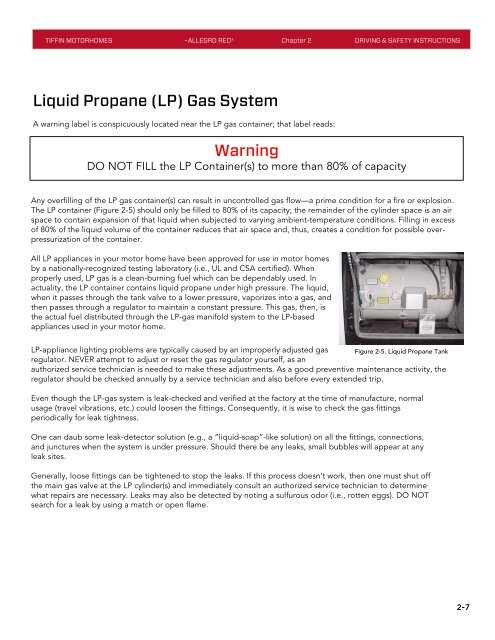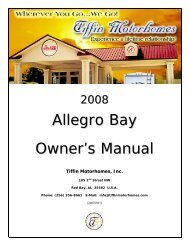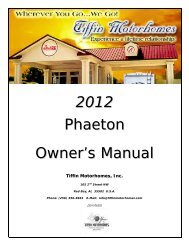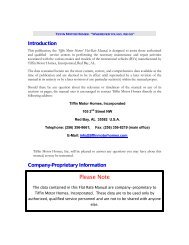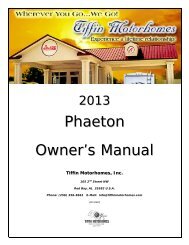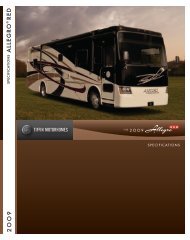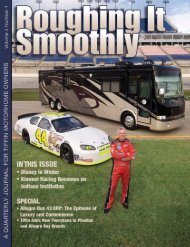Allegro RED Owner's Manual - Tiffin Motorhomes
Allegro RED Owner's Manual - Tiffin Motorhomes
Allegro RED Owner's Manual - Tiffin Motorhomes
- No tags were found...
You also want an ePaper? Increase the reach of your titles
YUMPU automatically turns print PDFs into web optimized ePapers that Google loves.
TIFFIN MOTORHOMES –ALLEGRO <strong>RED</strong>® Chapter 2 DRIVING & SAFETY INSTRUCTIONSLiquid Propane (LP) Gas SystemA warning label is conspicuously located near the LP gas container; that label reads:WarningDO NOT FILL the LP Container(s) to more than 80% of capacityAny overfilling of the LP gas container(s) can result in uncontrolled gas flow—a prime condition for a fire or explosion.The LP container (Figure 2-5) should only be filled to 80% of its capacity; the remainder of the cylinder space is an airspace to contain expansion of that liquid when subjected to varying ambient-temperature conditions. Filling in excessof 80% of the liquid volume of the container reduces that air space and, thus, creates a condition for possible overpressurizationof the container.All LP appliances in your motor home have been approved for use in motor homesby a nationally-recognized testing laboratory (i.e., UL and CSA certified). Whenproperly used, LP gas is a clean-burning fuel which can be dependably used. Inactuality, the LP container contains liquid propane under high pressure. The liquid,when it passes through the tank valve to a lower pressure, vaporizes into a gas, andthen passes through a regulator to maintain a constant pressure. This gas, then, isthe actual fuel distributed through the LP-gas manifold system to the LP-basedappliances used in your motor home.LP-appliance lighting problems are typically caused by an improperly adjusted gas Figure 2-5. Liquid Propane Tankregulator. NEVER attempt to adjust or reset the gas regulator yourself, as anauthorized service technician is needed to make these adjustments. As a good preventive maintenance activity, theregulator should be checked annually by a service technician and also before every extended trip.Even though the LP-gas system is leak-checked and verified at the factory at the time of manufacture, normalusage (travel vibrations, etc.) could loosen the fittings. Consequently, it is wise to check the gas fittingsperiodically for leak tightness.One can daub some leak-detector solution (e.g., a “liquid-soap”-like solution) on all the fittings, connections,and junctures when the system is under pressure. Should there be any leaks, small bubbles will appear at anyleak sites.Generally, loose fittings can be tightened to stop the leaks. If this process doesn’t work, then one must shut offthe main gas valve at the LP cylinder(s) and immediately consult an authorized service technician to determinewhat repairs are necessary. Leaks may also be detected by noting a sulfurous odor (i.e., rotten eggs). DO NOTsearch for a leak by using a match or open flame.2-7


